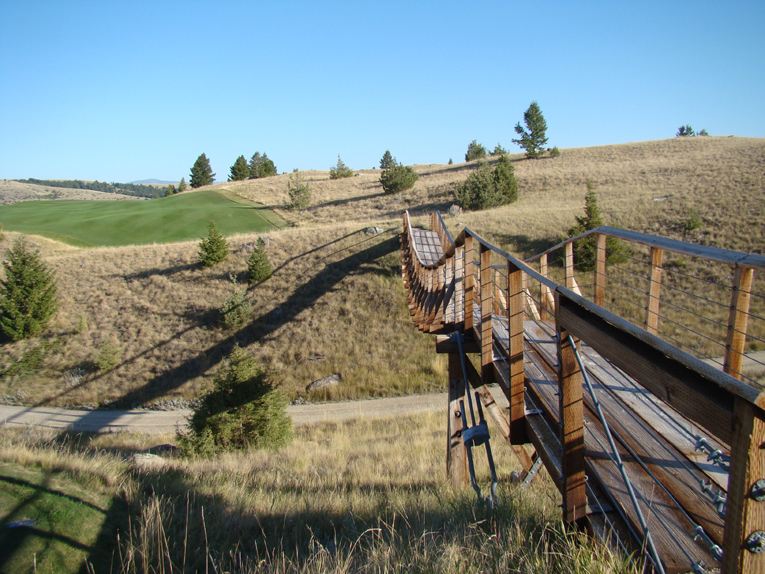Rock Creek Cattle Company
Montana, United States of America

The exquisite ground contours found at Rock Creek make the course every bit as good – and as much fun to play – as any course Tom Doak has ever done.
No architect grows up thinking about working in the rocky Northwest; the dream is to work in and out of sand dunes. Fortuitously, Tom Doak did that at Pacific Dunes in 2000. His success had a direct bearing on his subsequently winning three projects: Stone Eagle, Cape Kidnappers, and Rock Creek in the southern half of Montana near Deer Lodge.
In this case, businessman, vintner and avid golfer Bill Foley along with fifty partners desired establishing a golf course on the Montana ranch that they had acquired for ‘fishing and other recreation.’ One of his vice presidents Don DuBois (an ace player who won the California Amateur championship at the age of 40!) played Pacific Dunes a year after it opened. He came away so impressed that he enthusiastically recommended Doak for the project. The ‘con’ was the rocky conditions and the ‘pros’ were everything else with Doak being given access to 40,000 (!) acres. That’s right – five digits, though such a massive canvas creates its own challenge. On his first visit, Doak never made it to the section of the property where today’s course rests; the entrance drive alone ended up being 6.6 miles, that’s how immense it is! According to Doak, ‘We spent all of our time north of where the course is today. There was a lot of big, sweeping land but nearer to the creek there was some great contour that almost looked like links ground [except for all the rocks protruding]. When I got the maps, I later focused my search along the creek as the ground contours there were just perfect for golf fairways … very linksy in their undulations.’
Doak describes how the routing process unfolded once he focused his attention near the creek: ‘The first hole I saw on the topo map was #10 — actually, the second half of it, thinking about a short par-4. Then I looked for a good place to cross the creek, found #8, and then had to stare a long time to sort out how to get to it with #7. 6 through 14 came together pretty quickly after that. There were several different iterations of the starting and finishing holes, but those were a constant.’

Utilizing Rock Creek and getting the golfer across it was central to establishing the final routing.
Scores of permutations exist on property this size including a remote start. The fear for this was that people would ride up to the tee in a cart and stay in it the rest of the day. One of the thornier problems to overcome was finding the first several holes. The key was sending the first hole away from – and not along – Rock Creek. Doak is quick to credit Lead Associate Eric Iverson with that idea and the routing for the first three holes.
As it evolved, the course became a long loop up one side of Rock Creek and back down the other over rocky, undulating ground. The first six holes meander away from the clubhouse climbing 250 feet along the path of least resistance. Later, a series of dramatic drops occur to bring the golfer back near the clubhouse after the fifteenth green. Mr. Foley’s friend, Tom Devlin, suggested that the land below the lodge be utilized for the last three holes and the ultimate routing came together.

Rock Creek is too pretty to pollute with the noise of a cart. Far better to walk and enjoy complete immersion in nature.
The routing insured that the course would be good because so many distinctive holes were born but could it be great? Indeed, can a rocky site become world class? Templates don’t exist for building compelling holes in this part of the world as great golf never existed in Montana. Regardless of the setting, Doak adheres to his design tenets, which are well known through his writings and original works. These beliefs – that make golf fun for all, yet able to challenge the tiger – are embodied at Doak’s beloved Old Course in St. Andrews. As much as any course he has ever built, Rock Creek shares the same virtues.
The lessons learned from St. Andrews are realized in spectacular fashion here: a loop routing, width in the form of copious short grass, a preferred line off the tee that risks something in order to gain an advantage, central hazards that force the golfer one way or another, blind approach shots that ‘penalize’ those that take the cautious route, greenside slopes that repel, greenside slopes that gather, wind, and contoured putting surfaces. All these attributes exist at Rock Creek in spades. Every golfer enjoys St. Andrews – and that will hold true here as well.
Like all great links, the ground contours are what make Rock Creek extra special. Preserving them was a painstaking process. Doak notes, ‘We liked them so much that we had to spend a lot of time [and money] sorting the boulders out of them, instead of sand-capping the fairway, because we were afraid we’d lose contour.’ Helping Doak and Iverson were Brian Slawnik in the beginning, and Brian Schneider and Kye Goalby later. Jonathan Reisetter and George Waters joined in too.
The grassing scheme of Kentucky Bluegrass in the fairway proved an inspired selection. Greenkeeper Rick Hathaway’s mastery has it play firm – but not too fast. Unlike fescue courses where thin grass sends balls to similar locations, balls at Rock Creek have a way of hanging on the various mounds found in these fifty+ yard wide fairways. The result is that you constantly fiddle with stance and set-up. One day a ball might be slightly below your feet and on the next it might be above it with the good player appreciating the subtle differences required. Additionally, hole locations dramatically impact play. For example, a left hole location on 15 might find you aiming your tee ball fifty yards right of where you would for a left hole location. Few courses change anywhere near as much between rounds and members who come in for the week face a very dynamic examination. Like St. Andrews, Rock Creek epitomizes intelligent width, as we see below.
Holes to Note
(Please note: The II tees are referenced below and comprise a 6,735 yard course. The set of tees farther back measures 7,465 yards, making it the longest course Doak has ever built.)
Second hole, 435 yards; In metropolitan cities across the west and mid-west of the United States, prototypical tree-lined fairways inadvertently – and dully – define the tasks at hand for the golfer. Little thought is required; just hit down the middle. Such is not the case on an open, expansive canvas like Rock Creek. You have to get your bearings and that’s not necessarily easy as the challenge off the tee shifts from hole to hole, day to day. While you ought to hit a bunch of fairways, finding the proper side is not so simple. On the second the long bunker complex situated left off the tee and the solitary front right greenside bunker create the playing tension/strategy.

Whenever you see fairway bunkers at Rock Creek, ask yourself why? They often serve as a guide and playing close to them usually yields an advantage. Like a traditional links, there is no guarantee to see where your tee ball finishes at holes like the second.

Thankfully the second green complex wasn’t junked up with a bunch of puny man-made hazards. Far grander objects are here to admire!

The back left punchbowl – a feature generally found only at sand based courses – is but one of the many links like features encountered at Rock Creek.
Third hole, 545 yards; The length of par fives can serve many purposes to an architect. In this case, Doak slowly and imperceptibly transports the golfer 50 feet uphill by following the natural 3% incline for the hole’s entire length. Crucial to success is getting near or past a central bunker 100 yards short of the green in two as the 4,861 square foot putting surface is the second smallest target on the course (the eighth green is the smallest).

The afternoon light shows the beautiful folds in the third fairway. Despite the rock, great care was taken in the construction process to disturb the land as little as possible.

Greenkeeper Rick Hathaway ensures that the fairways run seamlessly into the bunkers. There is no (artificial) band of rough to impede a shot from running unceremoniously into these hazards. Though wide, the fairways play smaller than initially perceived.
Fourth hole, 440 yards; Holes two through six climb in a southerly direction. In the middle is this beast which might easily have been disheartening. The green’s location, tucked low in a saddle, enables friendly bounces for the pulled or pushed approach shot that is struck well enough. Feeble golf won’t earn as a good a result as bold, positive play.

Any architect can beat up a golfer but building a tough long uphill par four that is actually fun is a far more difficult task. Note how the distant green snuggles into a natural – and kind – saddle.
Fifth hole, 300 yards; Beautifully paired with the similar length downhill fifteenth, this uphiller offers three distinct options: 1) lay up short of the dune and wedge on with the bottom of the flagstick likely invisible 2) go forty yards right for the sake of playing one’s approach from a lie nearly level to the green’s elevation or 3) have a go for the putting surface with a favoring wind.

As seen from the tee, options are to play straight ahead at the bunkers on the left or to go long right over the bunkers in the right foreground.

Which approach shot do you prefer? The one above comes from playing left off the tee with a hybrid while …

… this one arises after playing high right off the tee (as seen in the morning). Much more of the putting surface is seen but additional risk was incurred off the tee. Note how the putting surface is draped over the natural grade of the land.
Sixth hole, 385 yards; An important component of any great course is mystery. If she reveals all her secrets after one or two rounds, her allure wanes. Far better that a course continually puzzles (i.e. aggravates!) the golfer. When the author asked several caddies what hole confused them the most, this was the surprise answer. The reason? A fifteen foot wall of fairway rises some 120 yards short of the green. To this day, the caddies remain unsure whether to advise players to hit close to its base (from where the approach is blind) or to lay back for the sake of seeing the green, albeit for a shot thirty yards longer. If not overdone, conundrums like this are an attribute, not a curse, for a design.
Seventh hole, 445 yards; So it begins: the seventh through the fifteenth is one of the game’s dozen or so most thrilling runs, up and down, across and around some intoxicating landforms. For the author, it’s every bit equal the drama and appeal of the great stretch of dunes holes at Ballybunion or Lahinch. From the course’s high point, the golfer tees off toward the sunken boulder in the middle of the fairway. Depending on the strike and the day’s playing conditions, a variety of outcomes ensue and yield approaches that range from a blind hybrid to a flip wedge to green in full-view. Such a gamut indicates great topography (!) but it’s generally reserved for linksland like the mighty eleventh at Ballybunion.

The holes at Rock Creek are named after western movies with the selection for the seventh coming as no surprise.

A big bold swing of the sort that Alister MacKenzie waxed lyrically about is called for on the seventh tee, which is the course’s highest point at 4960 feet above sea level.
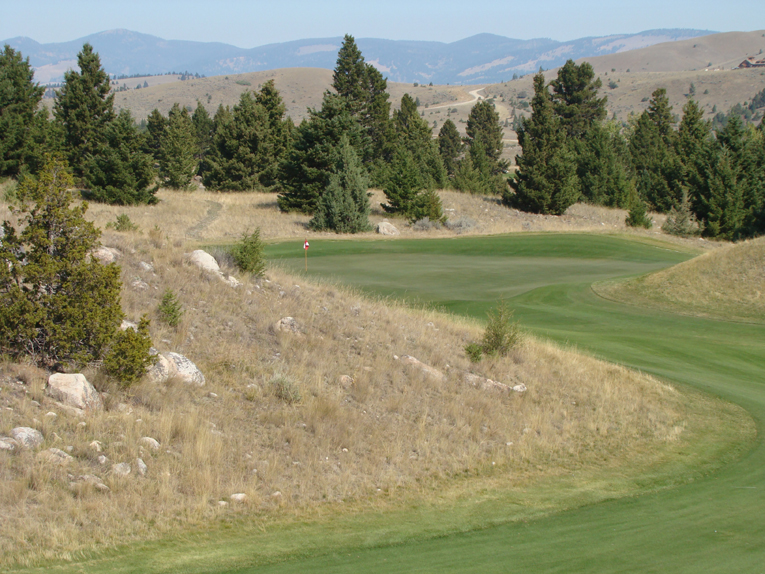
If not for the rocks on the hillside, one would swear that he is in the tumbling dunes on the southwest coast of Ireland.
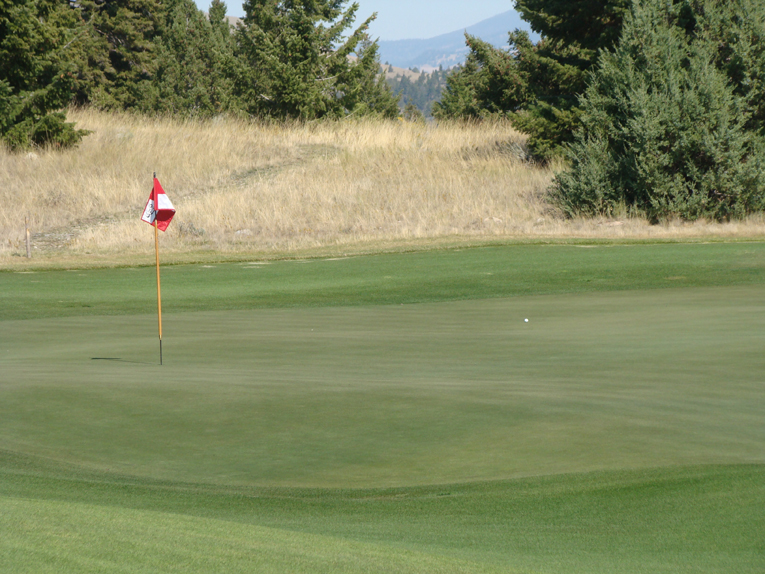
Yes, everything is large scale here but there are many moments where the golf plays to a human scale. Take this green complex: the false front matched with the back to front tilt of the green calls for a deft touch.

The seventh hole was the single hardest hole to find/envision, especially as the first ~400 yards of the hole was originally buried under trees. One could stare all day at a topo map and never come up with this hole. Doak eventually solved the puzzle and the resulting unique hole has been embraced by all.
Eighth hole, 175 yards; This is an especially rugged portion of the property though you might not guess it from the hole’s serene beauty. Postcard perfect, it epitomizes the quiet solitude that is Rock Creek. Days pass where even a jet’s plume isn’t seen and the only sound is that emanating from the rushing creek passing through its canyon. Solitude is one of the game’s greatest blessings and can be found on the Inner Hebrides at Askernish, at Highland Links on the tip of Cape Breton Island, in the dunes of Tasmania or here on the rugged ranch lands of Montana.

A meandering creek is a wonderful feature when used properly, like a par 3 where all golfers, regardless of ability, are given a perfect lie/stance from which to make the forced carry. The same feature would overwhelm most golfers on most days if it fell at the end of a long two shotter.
Ninth hole, 370 yards; Recall the comments made regarding the second hole and looking at fairway bunkers for guidance? Ignore that advice here! This hole curls left but assuming that a tee ball left is somehow beneficial would be wrong. Nothing is so simple on a Doak design. Here, it’s preferable to seek the high outside of the dogleg from where the sunken green comes into view. Even with that, a caveat applies in that back right hole locations may not be visible from the right side of the fairway.

On the domed ninth fairway tee balls that hit left of center are shunted toward the bunkers and approach shots from the inside of the dogleg are blind.
Tenth hole, 575 yards; There is width and there is Rock Creek width. As Doak notes, ‘We’ve built a lot of wide fairways but these are something else. The impetus here was all the rocks in the ground. We wanted to make a wide enough playable area so that people wouldn’t be taking drops [legal or illegal?] to avoid hitting a rock on their second shot … and once we tore up the ground to sift through it, it made more sense to make it all fairway than to have a belt of rough between the fairway and the native roughs.’ As outlined visually below, a rifle straight drive near a dominant hazard enables the opportunity for a spectacular shot to reach the green with two blows. Edge just 15-20 yards away from the hazard off the tee and one’s thoughts of reaching the green in two become measurably more complicated thanks to a high-lipped greenside pit of a bunker. The exacting playing angles for the tiger – coupled with the room to play for the rest of us – make this hole among Doak’s finest creations since starting his own architecture firm in 1989 upon finishing High Pointe.

Fairway is even found beyond the solitary bunker at the far right of the photograph on this supreme half-par hole.
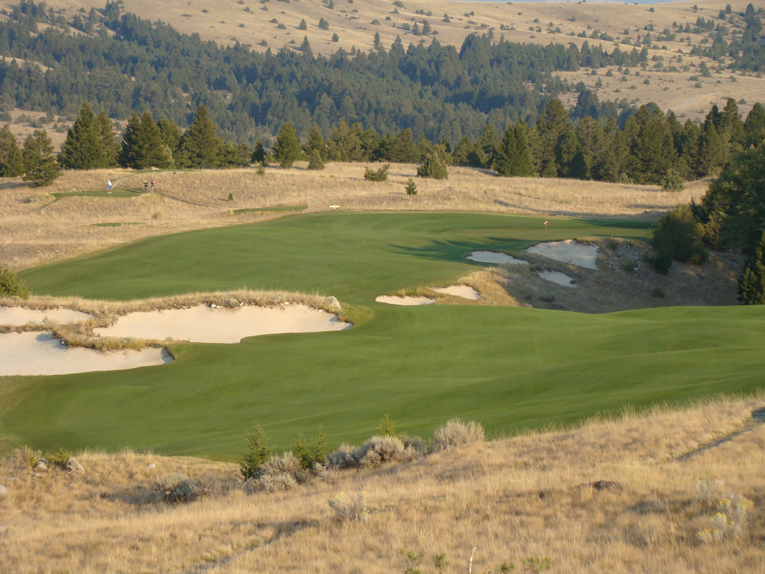
The zoomed view above spells it out for the tiger: Take the direct line toward the green from the tee by flirting with the massive left bunkers and enjoy the chance of reaching the green in two.

The prospects of pitching a ball close from the valley below is not great; far preferable to advance one’s second as close to green high as possible.
Eleventh hole, 410 yards; Rick Hathaway and crew maintain a whopping 59 acres of fairway turf for holes one through eighteen. One of the widest fairways in the world at 110 yards (!) is found here but it still manages to require a measure of precision. There is a level area near the two left hand bunkers where a much appreciated level lie awaits. This ~ twenty yard wide area greatly assists the golfer in finding the domed green that shrugs shots away in all directions. The author would vote this green as the single hardest target on the course to consistently hit and hold. How apropos that it comes at the end of such a gigantic fairway.

While the fairways is 110 yards (!) from side to side, it is one of the least friendly on the course.

Tee balls that peel slightly right are shunted well right and leave the golfer with a much tougher, longer and more elevated approach.
Twelfth hole, 150 yards; Problematic for a course with such width can be the one shot holes. They need to be multi-dimensional and play differently from round to round. Otherwise, they won’t feel like the same fabric as the rest of the course. As Lead Associate for two plus years, Eric Iverson had time to mull that over and make this hole work. Doak makes the point that ‘you can’t just build a postage-stamp green surrounded by rocks … too many balls will wind up on the rocks. So a short par-3 is one of the hardest holes to build. We used a lot of sand as buffer here.‘ In an early iteration, this green was at the end of a par four.
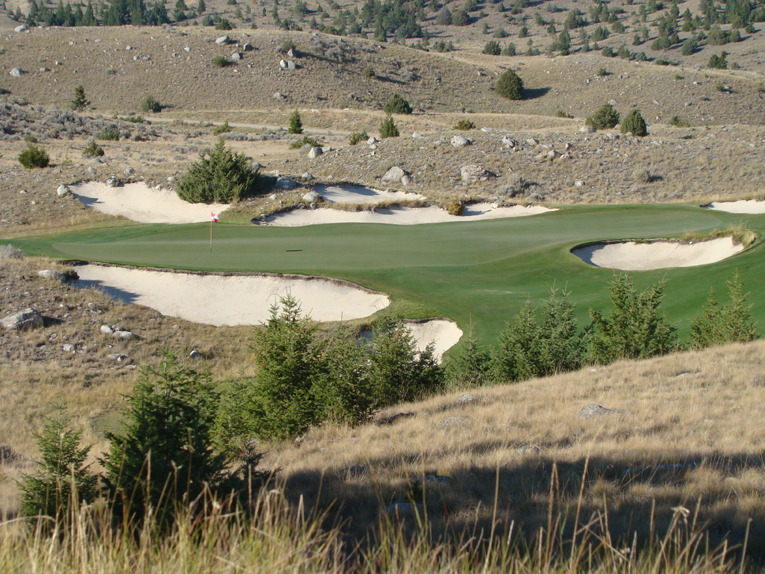
The elongated green extends 38 yards from front left to back right. Today’s left hole location poses a much different question than the middle or back right locations. Beware the false front bowl between the two bunkers.
Thirteenth hole, 220 yards; Architects these days all sound the same, despite having wildly differing styles. Each proclaims ‘I let nature dictate where the holes fell!’ but few actually do. Doak is the rare exception as demonstrated by these back to back one shotters. A clear rival to the sixth at Cape Kidnappers as Doak’s finest long par 3, the prospects from the tee shift with the weather. As a bonus, the ten plus mile view from behind this elevated green reminds the golfer that he is indeed in Big Sky country. Seeing contused clouds roll across the landscape is awe-inspiring.
Fourteenth hole, 455 yards; Ludicrously gorgeous, the scale of the hole takes one’s breath away. What a luxury/privilege to find oneself in this environment. There is no substitute for land and space that allows one’s spirit to soar. Cramped courses make for constrained people and this hole highlights how much better great golf is than good golf.

The twelfth is named ‘The Good’, the thirteenth ‘The Bad’ and, in a complete travesty, you guessed the fourteenth’s name!

Crucial to enjoying golf is hitting fairways. Given their width, that isn’t an issue at Rock Creek. How nice is it to play a hole of this magnitude from short grass? There are a lot of great holes around the world that golfers chop their way down. Here, a vast percentage of the day’s play occurs on short grass.

… the player who hits his tee ball far enough and keeps his tee ball right of center enjoys this scintillating view through a gap to the putting surface. The position of the tee ball seen above is A1A. Tee balls shorter and to the right will not afford the golfer a look at the green because of the right mound. This diagonal slot through the mounds is another inventive way of creating preferred positions within a big fairway.
Fifteenth hole, 300 yards; This downhiller clearly lays out the options for the golfer who readily sees the hole. Under certain conditions, the golfer delights in having a go for the green from the tee. Otherwise, the hole location dictates everything: if it is tucked right, the golfer is best served going left off and vice versa. The ideal position may be as different as 50 yards (!) between a tee shot left and one right.

The imperial view from the elevated fifteenth tee shows a sixty yard wide fairway and a shallow but wide green. Options galore emanate from the day’s hole location.

Not enough emphasis can be placed on the joy that the two to five foot fairway contours bring to a game of golf here.

This vicious right hole location offers little encouragement to the player with this right center tee ball.
Sixteenth hole, 425 yards; To this point, the golf on the inward nine has largely been played downhill. That now changes, just as the pressure mounts in one’s match, with the golfer confronting one of the most exacting drives of the round. The tension created between the bunkers cut high on the left to right slope and the solitary central one in the fairway is excellent. Additionally, the uphill approach calls for accuracy/care because the severe back left to front right tilt of the green can make even the best putter appear foolish.

The immediate and intense backdrops seen here and at the seventeenth are in wonderful contrast to the rest of the inward nine.
Seventeenth hole, 170 yards; Though it’s the third par three in five holes, none are vaguely similar – quite the neat design trick. This one drops into its own amphitheater with an abrupt stone wall behind and a creek left. The green with its roly-poly green contours is adept at eliciting one extra putt from the golfer and is the lowest point on the course, some 400 feet below the seventh tee.

The course doesn’t favor one shaped shot over another. Doak’s use of the creek at seventeen mirrors the challenge at the eighth.
Eighteenth hole, 555 yards; Some people grumble that the last hole offers something less than a satisfactory conclusion. Really?! The view from the tee, as seen below, should dispel that notion. The ‘hidden’ peril of the hole is the convoluted fairway contours in the landing zone that envelop the golfer who shies too far right away from Rock Creek. Griping occurs later on, after the golfer fails to realize his desired score because his second shot has gone awry from the awkward lie created by his timid tee shot.

The view from the Home tee with Rock Creek winding its way along the left of the fairway. Note how the fairway contours in the landing zone are more pronounced the farther one steers away from the creek.

The golfer needs to advance his second shot near these bunkers to enjoy a wedge into the Home green.
Doak opines, ‘I’ve always thought that Rock Creek was some of our best work and one of our most beautiful sites. I’m just glad we had the chance to work in Montana; it was one of the highlights of my career. And of all the places I’ve built, it’s the one my family really likes to visit. I wish we could get back there every summer.’
The pioneers of the game along the North Sea could have hardly imagined the far flung places where the game would be enjoyed. Despite growth for over a century, the game is suffering, especially in the United States where the game’s joy and ability to connect the player to nature has been severely diluted by the advent of real-estate driven golf. The preponderance of the 16,000 courses in the United States pale in comparison to their brethren in the United Kingdom. Why? They fail to inspire!
Golf is meant to be an invigorating pursuit, one that makes you appreciate all the good things in life. That happens in techni-color at Rock Creek. The most time-honored design features are found in an environment one wouldn’t typically associate with classical golf. The grandeur of the course’s setting and the shots that are required re-awaken the spirit. With child-like delight, you stay outdoors and play golf until dark. What Mr. Foley and Doak and his crew have accomplished here is extraordinary and as good as the game has to offer.
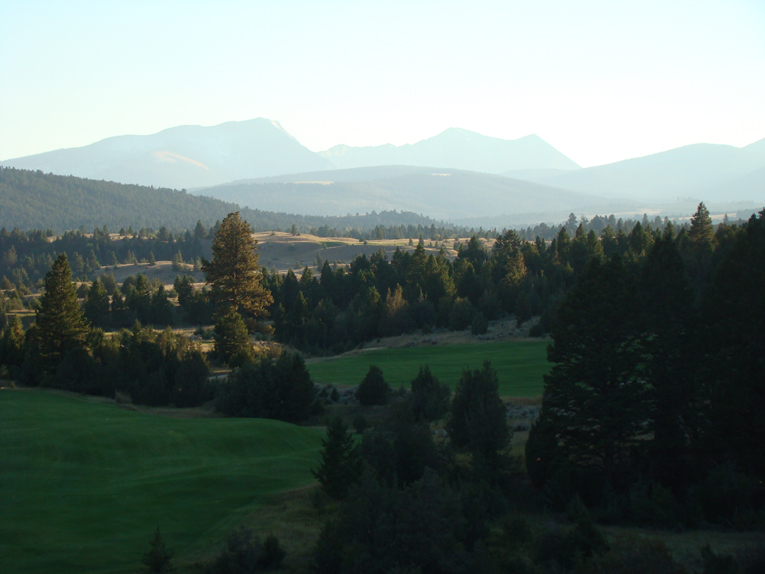
Another day of being in the great outdoors comes to an end with you having gained from the experience.








